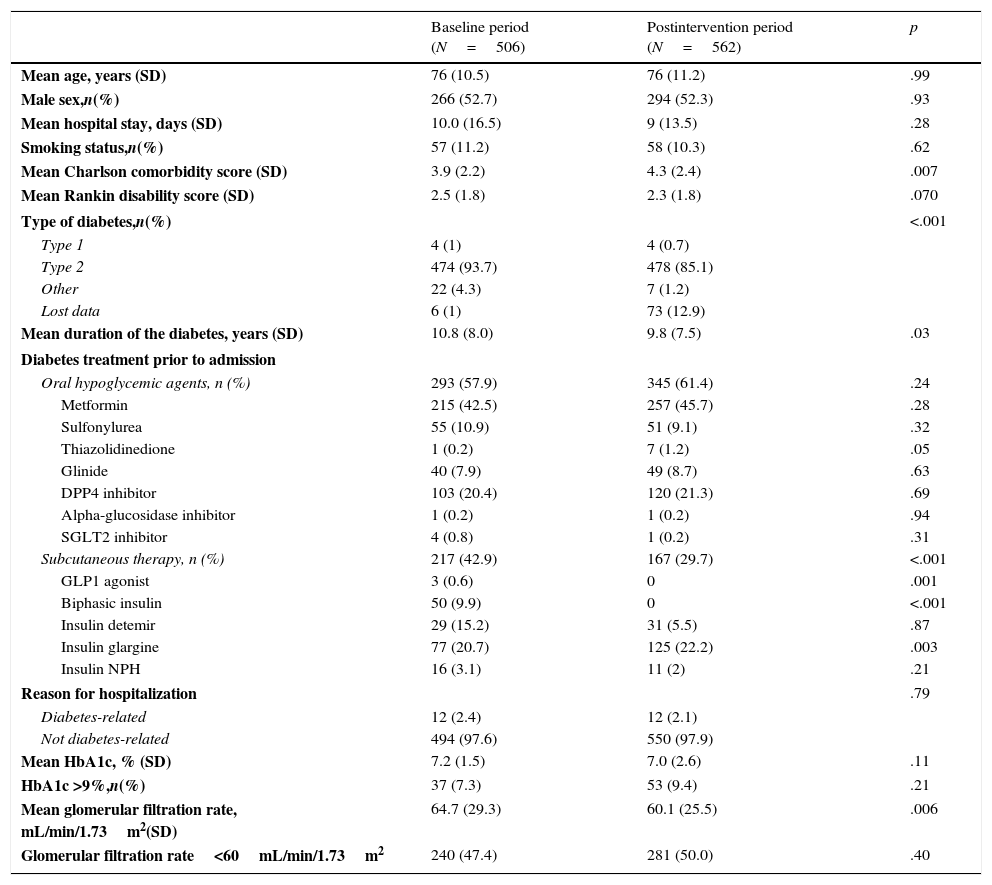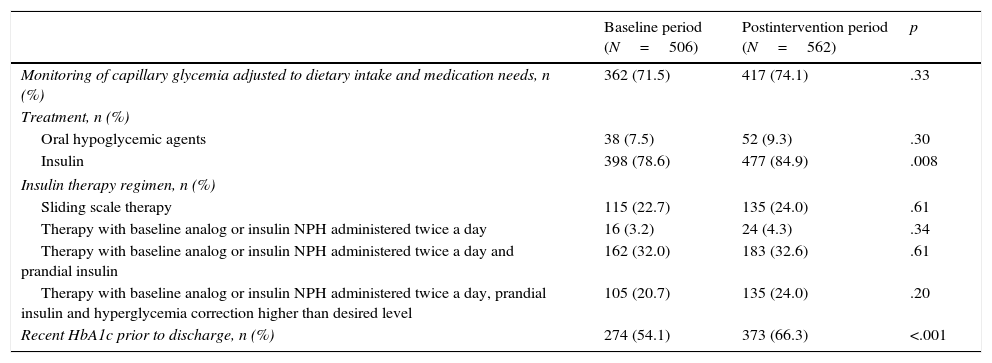We evaluated the effect of an intervention on certain quality indicators employed for improving the treatment of hospital hyperglycemia.
Material and methodsA multicenter cross-sectional study was conducted on patients with hyperglycemia hospitalized in the internal medicine departments of 44 hospitals evaluated in 2 time periods: 2014 (baseline period) and 2015 (postintervention period). The intervention consisted of the dissemination of the indicators obtained in 2014 and the objectives for improvement. As indicators, we assessed the frequency of glucose monitoring adapted to the patient's dietary intake or medication, the use of basal-bolus or basal-bolus-correction insulin therapy as the preferred control method of hyperglycemia and the recent availability of HbA1c prior to hospital discharge.
ResultsA total of 506 and 562 patients were assessed in 2014 and 2015, respectively. The results of the indicators in the baseline and postintervention periods were as follows: blood glucose monitoring adapted to the dietary intake or the medication (71.5 vs. 74.1%, p=.33), use of insulin in basal-correction regimen (32 vs. 32.6%, p=.61) or basal-bolo-correction (20.7 vs. 24, p=.20) and recent HbA1c value (54.1 vs. 66.3%, p<.001). The mean glucose values in the 24h prior to the study were similar in the 2 periods. The rate of hypoglycemia was also similar in both periods (3.3 vs. 2.3%, p=.31).
ConclusionsThere is a need to implement multimodal interventions to improve the treatment of hyperglycemia in patients hospitalized in noncritical areas.
Evaluamos el efecto de una intervención sobre determinados indicadores de calidad utilizados para mejorar el tratamiento de la hiperglucemia hospitalaria.
Material y métodosEstudio transversal multicéntrico de pacientes con hiperglucemia ingresados en servicios de Medicina Interna de 44 hospitales evaluados en 2 periodos: 2014 (periodo basal) y 2015 (periodo postintervención). La intervención consistió en la difusión de los indicadores obtenidos en el año 2014 y de los objetivos de mejora. Como indicadores se evaluó la frecuencia de monitorización de la glucosa adaptada a la ingesta o la medicación del paciente, el uso de insulina en régimen basal-bolo o basal-bolo-corrección como método de control de la hiperglucemia y la disponibilidad reciente de HbA1c previa al alta hospitalaria.
ResultadosEn el año 2014 se evaluó a 506 pacientes y en el 2015 a 562. Los resultados de los indicadores en el periodo basal y postintervención fueron los siguientes: monitorización de la glucemia adaptada a la ingesta o la medicación (71,5 frente a 74,1%; p=0,33), uso de insulina en régimen basal-corrección (32 frente a 32,6%; p=0,61) o basal-bolo-corrección (20,7 frente a 24%; p=0,20) y valor reciente de HbA1c (54,1 frente a 66,3%; p<0,001). Los valores medios de glucosa en las 24h previos al estudio fueron similares en los 2 periodos. El porcentaje de hipoglucemias también fue similar en ambos periodos (3,3 vs. 2,3%; p=0,31).
ConclusionesEs necesario implementar intervenciones multimodales para mejorar el tratamiento de la hiperglucemia en pacientes hospitalizados en áreas no críticas.
Article
Diríjase desde aquí a la web de la >>>FESEMI<<< e inicie sesión mediante el formulario que se encuentra en la barra superior, pulsando sobre el candado.

Una vez autentificado, en la misma web de FESEMI, en el menú superior, elija la opción deseada.

>>>FESEMI<<<









